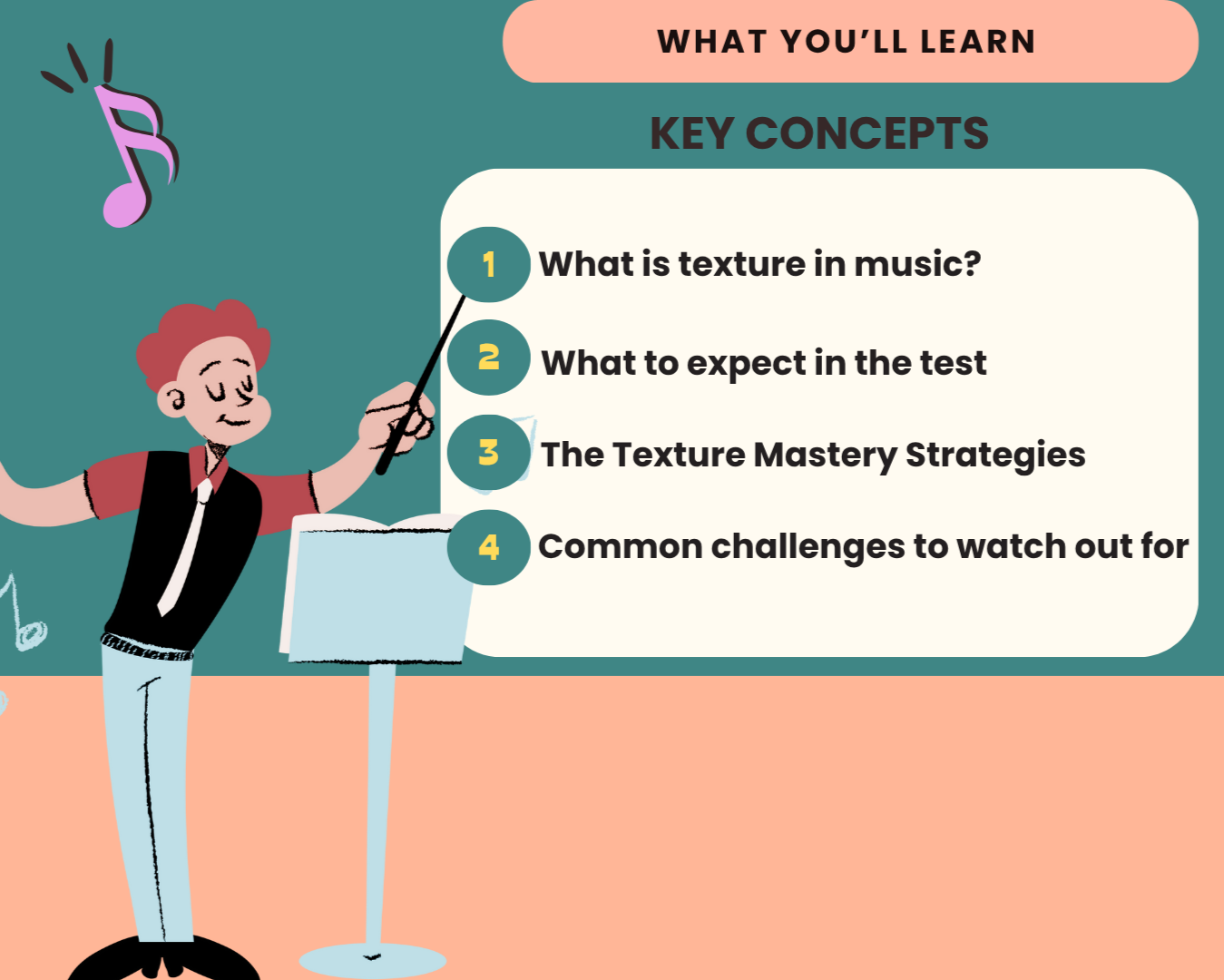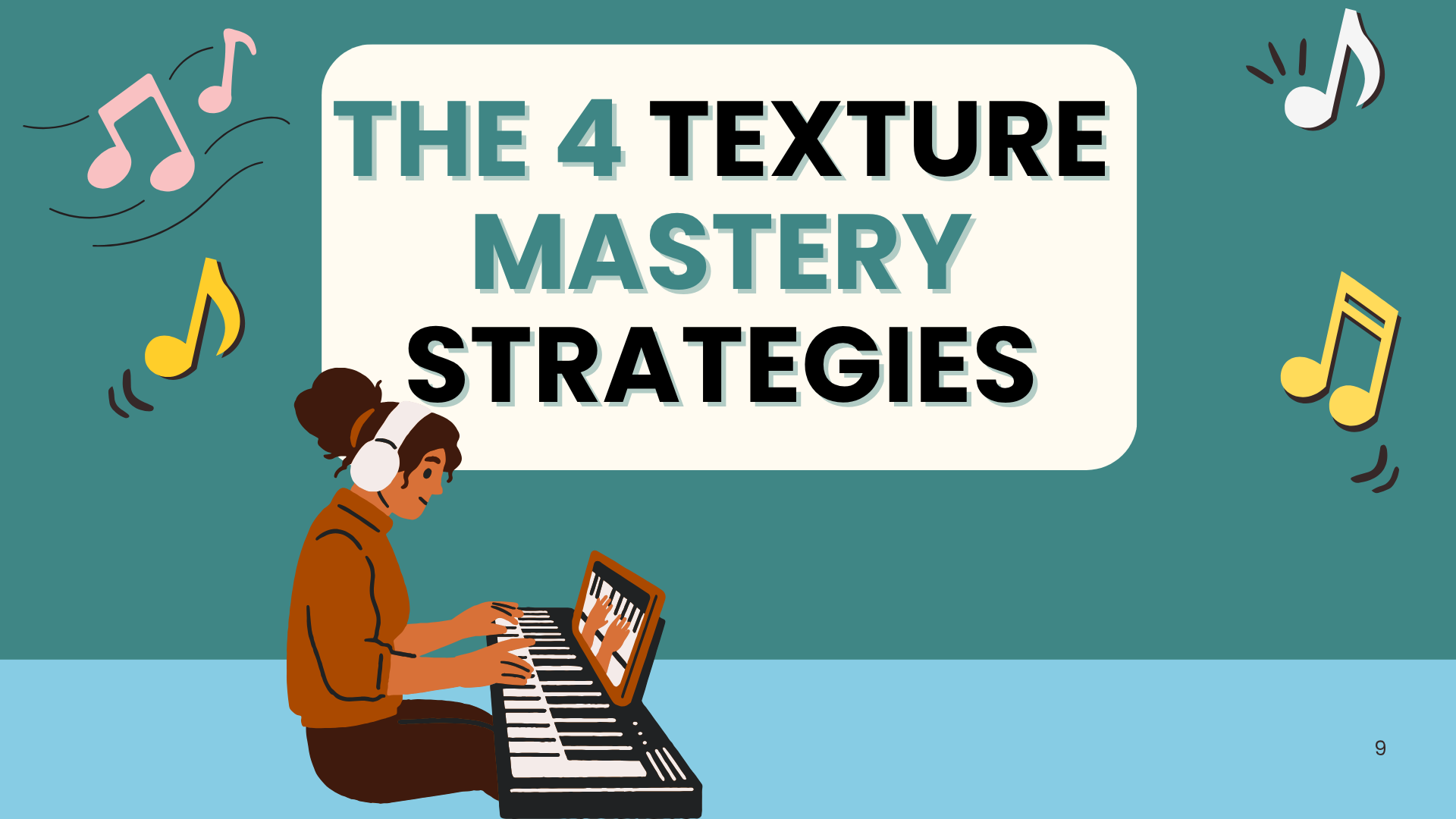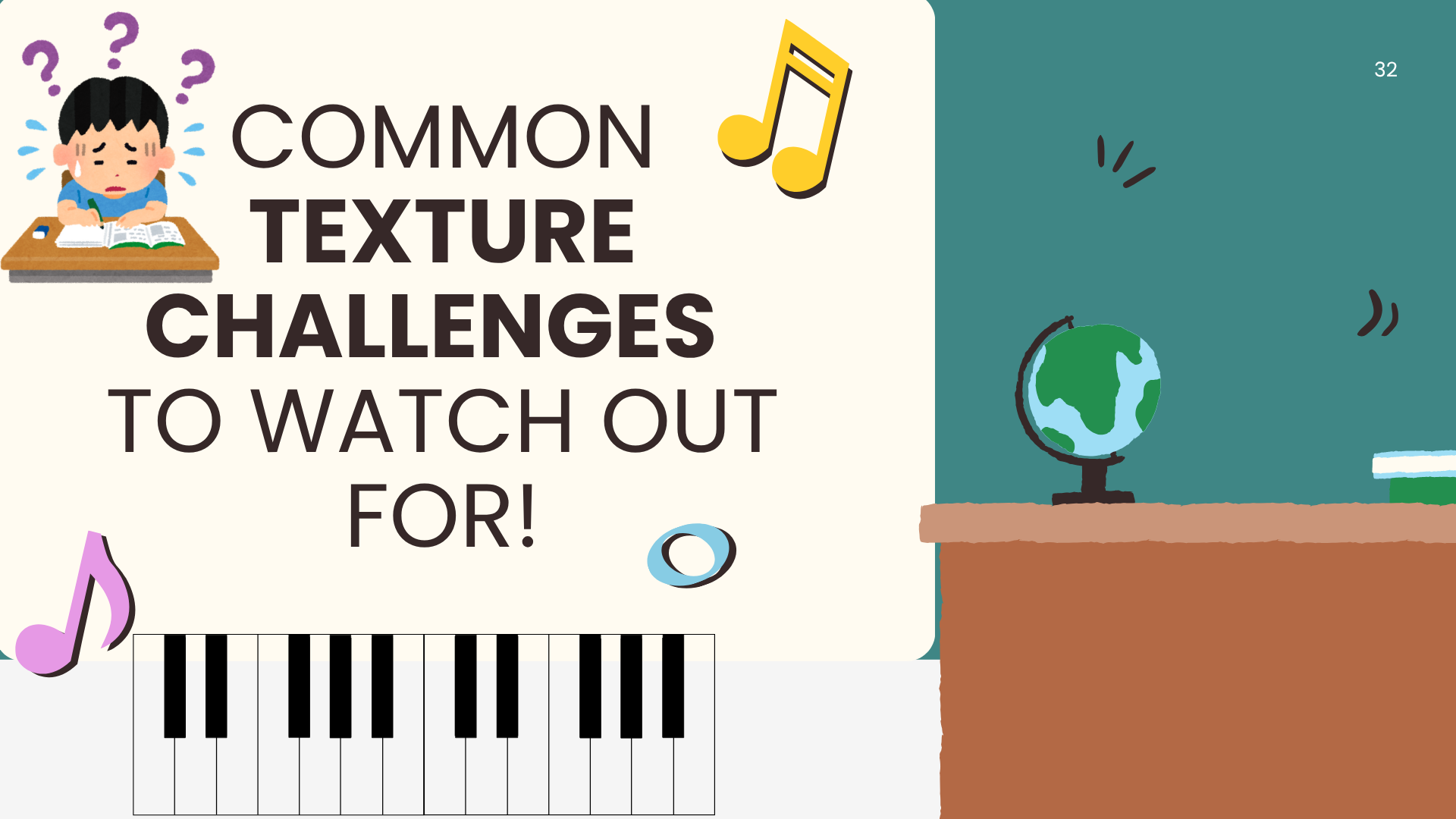
Ashbea Music Texture Masterclass
Welcome to the Ashbea Music Texture Masterclass. In this course, you will learn all the skills you will need to successfully navigate through, and pass, the Texture section in Stage 1 of the standard Music Aptitude Test (MAT).
-
Introduction
-
Introduction and Learning Objectives
Introduction and Learning Objectives
Welcome to the Texture Masterclass!
In this opening section, we introduce what texture means in music and why it matters for the 11+ Music Aptitude Test. You’ll discover what to expect in the test, what we’ll cover in this course, and how to begin training your ears with confidence and curiosity. -
What is Texture?
What is Texture?
Understanding musical layers.
Here, we break down the concept of texture in simple terms — explaining how the number of notes played at once creates different textures. We also look at how chords are presented in the test and what makes them easier or harder to hear.
-
-
The Four Texture Mastery Strategies
-
Strategy 1: Identify Highest and Lowest Notes First
Strategy 1: Identify the Highest and Lowest Notes First
Start at the edges.
The outer notes of a chord are your best clues. This section teaches you to hear and isolate the top and bottom notes first — then listen for anything in between. Includes guided examples of 2-note, 3-note, and 4-note chords with real-time feedback. -
Strategy 2: Use Your Inner Voice
Strategy 2: Use Your Inner Voice
Hear the music in your mind.
In this section, we introduce audiation — the ability to imagine sound silently. You’ll learn how to mentally “sing” the notes you hear in your head, a crucial skill since you won’t be able to sing out loud during the test. -
Strategy 3: Don't Be Fooled by Volume or Clashiness
Strategy 3: Don’t Be Fooled by Volume or Clashiness
Loud doesn’t mean complex.
A chord can be loud, fuzzy, or dissonant — but still have just two notes! This strategy helps you avoid common traps and instead focus on clarity and pitch, not intensity. Includes tricky examples to train your listening judgment. -
Strategy 4: Recognise Fuzzy, Heavy, Confusing Sounds
Strategy 4: Recognise Fuzzy, Heavy, or Confusing Sounds
Learn to trust how sound feels.
When a chord feels dense or blurry, it’s often a clue that four notes are being played. This section helps you connect to the physical feel of sound — developing your instinct for spotting heavier, richer textures.
-
-
Common Texture Challenges
-
Challenge 1: Extreme Registers
Challenge 1: Extreme Registers
High = fuzzy. Low = muddy. Now what?
In this section, we explore how chords played very high or very low on the piano can affect how clearly you hear the notes. You’ll learn why these registers are tricky and how to apply your strategies to avoid being misled by brightness or heaviness. -
Challenge 2: Note Spacing
Challenge 2: Note Spacing
Squashed vs. Spread Out – can you still count the notes?
Closely packed notes can sound blurry, while widely spaced chords might feel bigger than they are. This section helps you train your ears to focus on what matters — not how wide the chord is, but how many distinct pitches you can actually hear. -
Challenge 3: Octave Duplications
Challenge 3: Octave Duplications
Same note, different heights — how to spot it.
Sometimes, the same note is played in two octaves at once. This can make a chord sound richer — or more confusing. Here, you’ll learn to detect duplicated pitches and avoid being tricked into over- or under-counting the number of notes. -
Challenge 4: Adjacent Notes and Clashing Intervals
Challenge 4: Adjacent Notes and Clashing Intervals
Tense sounds, tricky textures.
Clashing notes that sit right next to each other on the keyboard — like a minor second or major seventh — can make a chord feel strange or harsh. This section shows you how these intervals affect texture and how to stay focused on counting, not reacting.
-
-
Summary and Practice Recommendations
-
Summary of Key Feelings
Summary of Key Feelings
How do chords feel in your body?
This quick recap explores how different textures make you feel physically and emotionally. Two-note chords often feel light; four-note chords feel rich and intense. These feelings are powerful tools in your decision-making during the test. -
Practice Recommendations
Practice Recommendations
What to do next at home.
Now that you've learned the core strategies, we’ll give you practical ways to continue training — using a piano, app, or even a friend or parent to help. Learn how to track your progress and make practice fun and effective.
-
-
Putting It All Together
-
Introduction to Final Tests
Now it’s time to put everything together and put your new skills to the test!
Using the strategies you’ve learned in this course, you’ll work through two full practice sets.Here’s how it works:
Each set contains 20 chords.
After each chord, you’ll have five seconds to think and give your answer.
The correct answer will appear right after the chord is played, so you can check yourself immediately.
Take a deep breath, focus your ears, and trust your training.
Good luck — you’ve got this! 🎵 -
Texture Masterclass Test 1
This first set of 20 chords focuses on high, low, and clashy registers, as well as both wide and close note spacing. Stay sharp and keep up the great work !🎹 💪🏽
-
Texture Masterclass Test 2
The second set of 20 exercises includes octave duplications in the high, low, and middle registers, along with adjacent notes and strongly clashing intervals such as minor seconds and major sevenths. Let’s smash this! 💥🎵
-
-
Conclusion
Meet your teacher
✳
Meet your teacher ✳
Bea Kampta
🎧 Welcome to the Texture Masterclass
Build confident ears for the 11+ Music Aptitude Test
In the Music Aptitude Test, there’s one deceptively simple challenge: you’ll hear a single chord — just once — and you’ll need to decide whether it contains two, three, or four notes played at the same time. Many students panic, guess, or rely on luck.
But with the right strategies and a bit of focused training, this can become one of the easiest parts of the test.
This Texture Masterclass is a step-by-step video course designed to help your child tune their ears, sharpen their instincts, and confidently identify musical texture — even when the chord is rich, fuzzy, or confusing.
Led by composer and music educator, Bea Kampta, the session includes:
Over 90 minutes of video lessons, exercises, tests, and tips
Easy-to-understand explanations of what texture means
Four powerful listening strategies your child can rely on
Loads of guided practice with real chord examples
Tips to overcome common traps like volume, dissonance, and duplication
Fun, body-based ways to connect with sound and trust your musical gut
Whether your child is just starting their 11+ Music Aptitude journey or brushing up before the test, this class will give them the tools to succeed — and the confidence to listen like a pro.
What you’ll learn
-
By the end of this masterclass, you will be able to:
Understand what texture means in music and how it applies to listening tests.
Master four specific strategies to identify musical texture.
Recognise different types of chords and how spacing, register, and note combinations affect what you hear.
Overcome common challenges and mistakes that many students face.
Tune into the emotional and physical feel of sound to guide your answers more intuitively.
-
You will go through the four core strategies and how to apply them in practice.
Using these strategies will help you master texture identification and make it easier to hear individual notes in chords.
-
You will explore some of the most common challenges you might face — and how to overcome them.
You will be able to practise using various examples across different registers (high, medium and low sounds).
Meet Alfred – he boosted his Music Aptitude Test score after taking our Texture Masterclass! 🎹💪🏽
Course FAQ
-
The Texture Masterclass is a digital course designed to help children prepare for the texture section of the 11+ Music Aptitude Test. In this section of the test, students hear a single chord and must identify whether it contains two, three, or four notes played at once. The masterclass teaches listening strategies and offers guided practice to build confidence and accuracy.
-
This course is ideal for:
Children aged 7–10 preparing for the 11+ Music Aptitude Test (e.g. for selective state schools with music places)
Parents looking to support their child’s musical development at home
Music teachers and tutors seeking effective texture training tools for their students
No prior theory knowledge is required — just open ears and curiosity.
-
Your child will learn how to:
Understand musical texture and how it's tested in the 11+ MAT
Use four powerful listening strategies to identify 2, 3, or 4-note chords
Recognise chords by their sound, feel, and spacing
Overcome common challenges like fuzzy chords, extreme registers, and clashing notes
Develop inner hearing (audiation) — a vital musical skill
Build confidence and intuition through practice
-
The Texture Masterclass is a pre-recorded video lesson, which you can watch at your own pace. It includes:
Demonstrations of real chord examples
Step-by-step explanations of each strategy and common mistakes
Practice prompts for your child to join in with (including singing and inner hearing)
A downloadable practice guide to use at home
Once purchased, you’ll receive immediate access and can replay the lesson as often as needed.
-
It’s suitable for all ability levels. While musically trained children will enjoy sharpening their ears, beginners will benefit from the clear explanations and guided practice. The masterclass focuses on listening skills, not reading music or playing an instrument.
-
Absolutely. The Texture section of the 11+ Music Aptitude Test gives students only one chance to hear a chord. This masterclass is specifically designed to:
Replicate real exam conditions
Teach practical tools to make quick, accurate decisions
Train the ear to pick up on subtle clues, like spacing and density
We’ve seen students go from guessing to confidently identifying textures after just one session.
-
Unlike generic ear training apps or theory books, this masterclass:
Focuses only on the Texture question from the 11+ MAT
Uses child-friendly language and real-life analogies (like “fuzzy,” “clear,” or “heavy” sounds)
Teaches how to listen, not just what the right answer is
Combines logic and intuition, helping students trust their musical instincts
It’s not just about ticking boxes — it’s about developing a deep listening skill that will serve your child in exams and beyond.
-
No piano is required for the course itself, but we do recommend using a real piano or a piano app for ongoing practice.
In the masterclass, we’ll also share simple ways to create chords at home (e.g. with a family member or tutor) for extra ear training after the session. -
The core video lesson runs for approximately 90 minutes, broken into:
Clear explanation segments
Interactive listening and response activities
Practice exercises with real chord examples
Recaps and strategy reminders
You can pause, rewind, and revisit it anytime.
-
Yes! The course includes a downloadable practice guide summarising the four strategies, common challenges, and suggested activities.
You’ll also have access to email support at hello@ashbeamusic.com -
Yes — once purchased, you have lifetime access to the Texture Masterclass. You can rewatch it as many times as you like, whether for first-time learning or final test prep closer to exam day.




